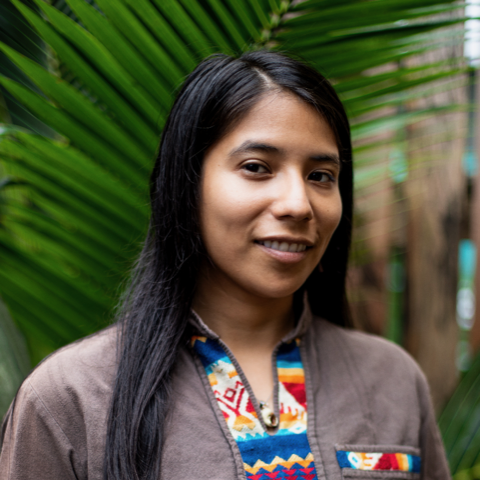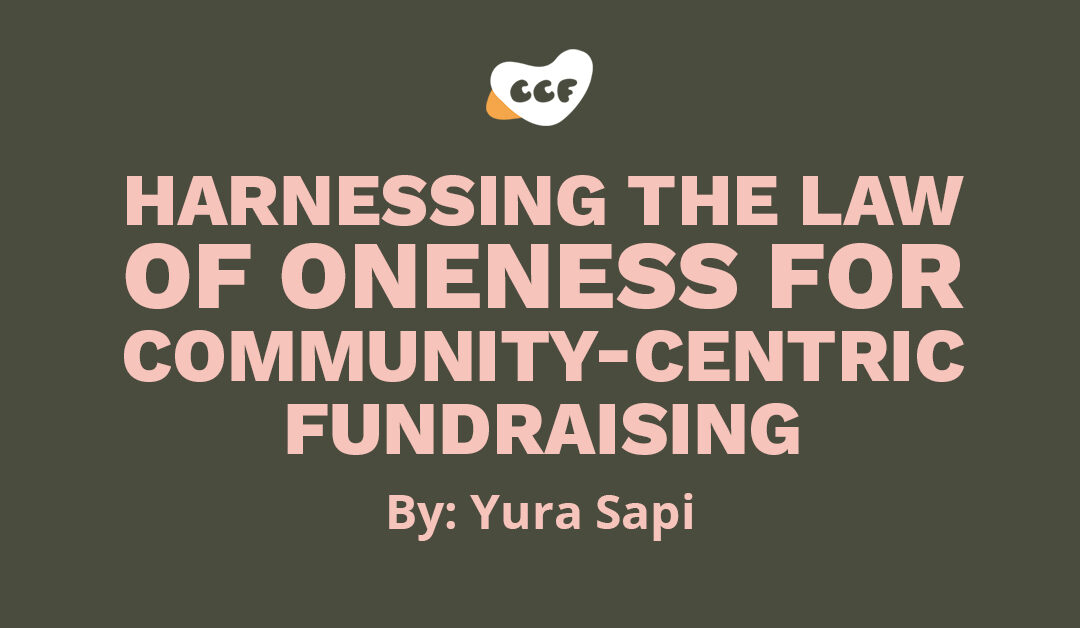By Yura Sapi, healing artist, Earth being, and nonprofit leader
By embracing the principles of community-centric fundraising (CCF) through the lens of the Law of Oneness, we unlock access to our collective consciousness that transcends our individual efforts and maximizes our impact toward equity, social justice, and community well-being. We become the transformative change we’re yearning for and cause an exponential ripple effect around us.
The Universal Law of Oneness is the idea that we are all connected, that we— meaning everything— are all one, and that we represent different variations of the same oneness.
In my personal journey, I have explored the Law of Oneness in order to understand and overcome my anger. I encountered the concept of the 12 Universal Laws, which further deepened my connection to nature, the Earth, the Universe, and our collective existence that I have been cultivating while living in a remote and rural area of the world, Nuquí, Chocó, Colombia.
I found myself mesmerized by the intricate happenings of life in the forest. The ants working away as a team, the plants ever so slowly— in our perception of time— moving towards the light, growing leaves and flowers in specific patterns and textures. I got to experience more of this wisdom of nature in the way their systems work for a reason. Watching the river flow gave me the lesson of continuing to flow myself. This invitation reflected back at me to keep moving along with my tasks instead of getting stuck and caught up in things I don’t actually care about. Breathing in the oxygenated air in the forest and then breathing out the carbon dioxide that the forest needs helped me tap into the pure reciprocity that comes from being alive on this planet.
Now, I feel drawn to share these insights and contribute to the CCF movement.
Accessing a powerful heart-anchored interconnectedness to increase our compassion
By accessing this profound heart-anchored interconnectedness, we are able to understand compassion in a deeper way
It starts with the heart. By grounding ourselves in our heartbeat, we connect to the core of our being and so connect to the core of the Earth. By connecting to the Earth, we connect to the Sun, and the vast universe that encompasses our existence. By connecting to the universe we connect to the origin of the universe– all that was, is, and will be. There’s a unity in who we are.
As we contemplate the interconnected nature of our existence, we realize that we are all composed of the same fundamental particle wavelengths.
Sherri Mitchell, in her book, Sacred Instructions discusses how our DNA is shared with every other living being– we share approximately 98% with primates and 35% with plants. We’re all made of the same foundational elements that exist as a vibrational frequency. We are sounds like the Big Bang that created this existence was a sound.
This realization opens the door to accessing the universal frequency through our hearts and cores, and aligning with the essence of the Earth, the Sun, and the expansive universe. Within us, the steady rhythm of our heartbeat is a gateway, inviting us to tap into our inner knowing and wisdom.
We shift away from relying on intellect, on thinking our way through, and on a colonial and oppressive perspective. We shift towards embracing the wisdom that emanates from our heart, our connection to the source, everything, and each other. The way that the cells in our body are part of our body, we, as individuals, are part of a larger ecosystem.
By accessing this profound heart-anchored interconnectedness, we are able to understand compassion in a deeper way too.
I recognized that my life is a mirror reflecting back to me my own lessons, experiences, and interactions. What frustrates or angers me in others reflects what frustrates or angers me in my own actions. I hate when someone isn’t treating others fairly, justly, or equitably, and I also hate when I do or have done that to others. By tapping into the gifts of our emotions, we receive information about ourselves. By cultivating self-compassion, we open ourselves to extend compassion to others. As we release hatred towards others, we simultaneously release the internal hatred we harbor.
By becoming a sacred witness to my own fear, holding space for it, and taking a moment to separate from it, I’m able to move beyond allowing it to guide my actions. By doing this internally for ourselves, we create space for the collective fears of our society and our communities to be acknowledged and transcended, going beyond the limits of these fears.
How our new compassion can be used to improve our community-centric fundraising practice
The Law of Oneness can be applied to all the principles of CCF. I welcome you to journal, sing, draw, meditate, or otherwise reflect on your own about each of the principles and how you are one with them (as well as everyone else who is applying them or not to this collective work).
When we begin our journey in community-centric fundraising we start with training to help us ground ourselves in race, equity, and social justice. I change my perspective of being angry that my organizations or others aren’t making more effort to educate themselves, and instead, I look inward.
I ask, where in my life am I frustrated at myself for not doing enough? I create actionable steps to look toward addressing my own gaps of understanding. By taking an anti-racist training myself, I am able to have a transformative experience, share the information and teachings from that training with others, and get others excited about training. Perhaps I also meet others in that training that now allow me to feel less alone in this work, and we build community.
All of a sudden, there is a ripple effect. By making the frustration or the problem part of me – one with me – I accept it as part of me, address it within me, and offer healing around me.
I’m part of a group called Artist Co-Creating Real Equity (ACRE) which I joined after taking the Undoing Racism Training with the People’s Institute for Survival and Beyond. Continuing to go to these meetings with ACRE is about continuing being in community for our anti-racist work. Our work in solidarity with each other is ongoing and never ending and so the training continues and evolves into practice.
In the next step in our journey in community-centric fundraising, we encourage donors to think about race, equity, and social justice. To begin, I ask myself, where am I being a donor?
To many around the world, $1 USD a month makes a real impact. As U.S. workers, we can make a global impact with our “small” donations. We also know from our community-centric principles that we can support local community organizations we benefit from by donating our skills, time, and material goods they may need. As a fundraiser, I’ve found it essential to be a donor, too, and to consider my own privileges, especially in a global context.
When it comes to investing in fundraisers who come from the communities that we serve–I turn that inward, too, and ask how can I invest in myself as a fundraiser for my own community? What are the services or places that are supporting me, and how can I believe in myself as a fundraiser for my own community?
To address the practice of inequitable Trickle-Down Community Engagement, I ask where can I redistribute funding that comes in directly to a marginalized community I am representing? Mica Rose talks about this in a podcast episode on Building Our Own Tables. “I sometimes go to queer resource centers at colleges,” Mica shared, “I teach parts of my practice and all of the money we charge up big because the institutions, they got it. These places with endowment, they got it. And we take all of that money and we find the ways to get it back to the communities facing the direct violence and opposition of the state.”
The Law of Oneness can be applied to all the principles of CCF. I welcome you to journal, sing, draw, meditate, or otherwise reflect on your own about each of the principles and how you are one with them (as well as everyone else who is applying them or not to this collective work). Here are some statements you can use as reflection tools to help you get started:
First principle – I embrace racial equity and social justice, acknowledging my privileges and investing in my growth as a fundraiser for my community. I redistribute resources to uplift marginalized communities.
Second principle – I align my mission with the collective community, and I regularly assess its relevance and responsiveness. I adapt, collaborate, and pause when necessary.
Third principle – I practice generosity and mutual support, giving to others with the understanding that I, too, receive support. I actively participate in other’s events and identify other community groups to uplift.
Fourth principle – I respect, appreciate, and recognize my value to the community I strengthen by being a staff member, by serving on boards, by being a volunteer, and by being a client.
Fifth principle – My time is as valuable as my money, and I donate it accordingly. I honor and appreciate those who donate their time to support me.
Sixth principle – As a donor (of time and money), I seek to deepen my understanding of race, equity, and social justice. I engage in transparent and occasionally challenging conversations with those I support.
Seventh principle – I invest in spaces where I feel a sense of belonging, and I let go of spaces where I am made to feel “othered” or in need of being “saved.”
Eighth principle – I personally benefit from my donations (time and money), recognizing that investing in other causes strengthens our community as a whole.
Ninth principle – I donate holistically and transformationally, supporting core “overhead,” which creates lasting impact.
Tenth principle – I am committed to economic justice and actively address the root causes of inequity in my life. I acknowledge the effects of capitalism and work to dismantle them, inspiring change in myself and others.
The power we have in adjusting our energy, our state of being, our thoughts, and our love towards ourselves affects how we can be with others. One interaction with another can change the way they interact with everyone else, and we have a ripple effect when we focus on the internal.
Through this transformative journey of self-reflection and embracing the Law of Oneness, we can align ourselves with the interconnected fabric of existence. As we tap into the wisdom of our hearts, I invite you to join me in exploring what arises from this shift—an invitation to decolonize our source of answers and solutions to the challenges we face. By recognizing the interconnectedness of our lives and embracing compassion and unity, we pave the way for collective healing and foster a society and community guided by love, understanding, and shared purpose.

Yura Sapi
Yura Sapi is Kichwa Indigenous and mestiza, Ecuadorian and Colombian gender non-binary being of Earth. Their work as a mutli-disciplinary creator extends beyond U.S. borders prioritizing anti-racism and decolonization for our collective liberation. Yura builds racial, social and climate justice with their nonprofit, LiberArte. Yura writes from Embera native land in Nuquí, Chocó on the Afro-Indigenous pacific coast of Colombia with a lifelong connection to their birthplace on Mannahatta island in Lenapehoking. Connect with Yura on Instagram, LinkedIn and their website at yurasapi.com. You can tip them via Venmo @yurasapi, PayPal or by making a donation to LiberArte. You can also engage with their work in workshops, courses, coaching, meditation and healing sessions.
Discover more from CCF
Subscribe to get the latest posts sent to your email.


Thank you so much for sharing your beautiful story. I am inspired!
I will continue to keep in touch.